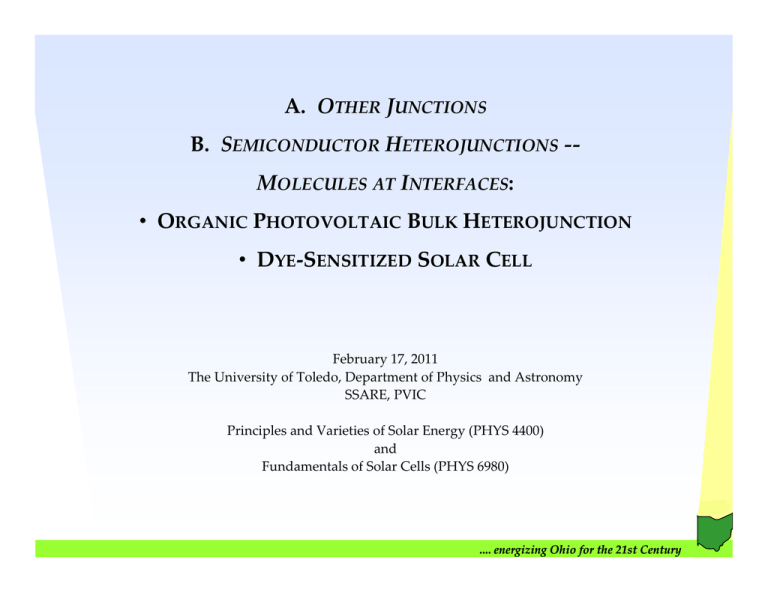O S : P
advertisement

A OTHER JUNCTIONS A. O B. SEMICONDUCTOR HETEROJUNCTIONS ‐‐ MOLECULES AT INTERFACES: • ORGANIC PHOTOVOLTAIC BULK HETEROJUNCTION • DYE‐S SENSITIZED SOLAR CELL February 17, 2011 The University of Toledo, Department of Physics and Astronomy SSARE, PVIC Principles and Varieties of Solar Energy (PHYS 4400) and Fundamentals of Solar Cells (PHYS 6980) .... energizing Ohio for the 21st Century .... energizing Ohio for the 21st Century p‐n junction and semiconductor physics review A note on units: looking at the Continuity equation(s) – units for dn/dt are cm‐3s‐1. Units for (1/q)(dJ/dx) work out to be: (C‐1)(C s )(C s‐1 cm‐2)(cm‐1) = cm ) = cm‐3s‐1. .... energizing Ohio for the 21st Century .... energizing Ohio for the 21st Century p‐n junction and semiconductor physics review Poisson’s Equation dEˆ q ( p n N D N A ) dx Straightforward definitions: E is the electric field is the charge density is the charge density q is the magnitude of the electron charge p is the concentration of free holes n is the concentration of free electrons ND+ is the concentration of ionized donor atoms (recall that donors donate electrons, leaving them positively charged) NA‐ is the concentration of ionized acceptor atoms (recall that acceptors accept electrons, leaving them negatively charged) .... energizing Ohio for the 21st Century .... energizing Ohio for the 21st Century Semiconductor physics review Density of States in Conduction and Valence Band (parabolic b d band approximation) i i ) Look at units: Look at units: (note that 1 J = 1 kg‐m‐ s‐2, and [h] = m2kg s‐1) Fermi function (state occupation probability) 3/ 2 N C E mn NV E mp 2 2 3 3/ 2 2 2 3 E EC EV E kg 3 / 2 J 1/ 2 s 3 kg 3 / 2 kg 1/ 2 s 3m 1 2 5 1 3 kg s m J m 6 3 6 3 m kg m kg s 1 f E E EF 1 exp kT .... energizing Ohio for the 21st Century .... energizing Ohio for the 21st Century Boltzmann approximation FFermi function (state i f ti ( t t occupation probability) 1 E EF 1 exp k BT f E If EF is sufficiently far from either band edge, then f(E) can be approximated by: If E i ffi i tl f f ith b d d th f(E) b i t db EF E f E exp k BT From the textbook’s (3.27), then, we can integrate to arrive at n: n N C E f E , EF , T dE EC Integrating/solving for n yields (3.31): n N 0 exp(( EF EC ) / k BT ) Where N0 is called the effective conduction band density of states and is given by mc*k BT N 0 2 2 2 3/ 2 .... energizing Ohio for the 21st Century .... energizing Ohio for the 21st Century Optical absorption: direct vs. indirect gap From the textbook’s Chap. 4, “Generation and Recombination” p , k k (4.43): E g c Ei E g v Ei dEi Quantity in integral known as the joint density of states (JDOS). For the parabolic band approximation and a direct‐gap semiconductor, it follows that: (4.44) E 0 E E g 1 2 where 0 is a material where is a material‐specific specific constant. constant. For an indirect gap semiconductor, one needs to account for the probability of finding a suitable phonon for the 3‐particle (indirect) transition process. g p p ( ) p (4.47) E E E g 2 The textbook notes that the form for shown in (4.44) is rarely seen in practice… .... energizing Ohio for the 21st Century .... energizing Ohio for the 21st Century Types of recombination (revisited) 1 bulk 1 SRH 1 Auger 1 rad .... energizing Ohio for the 21st Century .... energizing Ohio for the 21st Century Radiative (direct) and Auger recombination U Bnp where U is the rate of recombination of e‐h pairs due to radiative band‐to‐ where U is the rate of recombination of e h pairs due to radiative band to band recombination, n,p are the electron and hole concentrations, and B is a constant dependent on the material and the specific process. Auger recombination is a 3‐carrier (or 3‐particle) process involving either two electrons and a hole, or one electron and two holes: U Auger Ap n 2 p n02 p0 for two‐electron collisions for two‐hole collisions U Auger An np 2 n0 p02 .... energizing Ohio for the 21st Century .... energizing Ohio for the 21st Century Junctions Reading assignment (if not previously assigned): Chapters 5 (Junctions) and 6 (Analysis of the p‐n Junction) from Ch 5 (J i ) d 6 (A l i f h J i )f “The Physics of Solar Cells” Work Function: potential Work Function: potential required to remove the least tightly required to remove the least tightly‐ bound electron: w Evac EF Work function equals the electron affinity in metals. .... energizing Ohio for the 21st Century .... energizing Ohio for the 21st Century Bases for effective fields at junctions Charge‐separation mechanisms • gradient in the vacuum level or work function electrostatic field (e.g., doping level) • gradient in electron affinity gradient in electron affinity effective field effective field • gradient in the band gap effective field • gradient in the band DOS effective field .... energizing Ohio for the 21st Century .... energizing Ohio for the 21st Century Metal‐semiconductor junctions: Schottky‐barrier .... energizing Ohio for the 21st Century .... energizing Ohio for the 21st Century Metal‐semiconductor junctions: Schottky‐barrier (cont.) .... energizing Ohio for the 21st Century .... energizing Ohio for the 21st Century Metal‐semiconductor junctions: Schottky‐barrier (cont.) .... energizing Ohio for the 21st Century .... energizing Ohio for the 21st Century Metal‐semiconductor junctions: Schottky‐barrier (cont.) .... energizing Ohio for the 21st Century .... energizing Ohio for the 21st Century Metal‐semiconductor junctions: Ohmic contact .... energizing Ohio for the 21st Century .... energizing Ohio for the 21st Century Organic PV: Bulk heterojunction http://depts.washington.edu/cmditr/mediawiki/inde x.php?title=Organic_Heterojunctions_in_Solar_Cells http://www‐ssrl.slac.stanford.edu/sites/default/files/science‐ highlights/images/2011/January/Verploegen‐‐fig1_0.png .... energizing Ohio for the 21st Century .... energizing Ohio for the 21st Century Organic PV: simplified BH structure http://www.light.t.u‐ tokyo ac jp/english/photovoltaic/Introduction html tokyo.ac.jp/english/photovoltaic/Introduction.html http://www.cfn.uni‐karlsruhe.de/?id=221 M. Al‐Ibrahima et al., Solar Energy Materials & Solar Cells 85 (2005) 13–20 .... energizing Ohio for the 21st Century .... energizing Ohio for the 21st Century Organic PV: interface energetics http://www.physik.uni‐ wuerzburg.de/EP6/research‐oe.html http://depts.washington.edu/cmditr/mediawiki/images/8/84/Or ganicheterojunctions.JPG .... energizing Ohio for the 21st Century .... energizing Ohio for the 21st Century Dye‐sensitized TiO2 solar cell ~25 nm nano‐porous TiO2 electrode HOMO‐LUMO transition “Reaction”: S + h S* S+ + e‐ M. Grätzel / Journal of Photochemistry and Photobiology C: Photochemistry Reviews 4 (2003) 145–153 .... energizing Ohio for the 21st Century .... energizing Ohio for the 21st Century Dye‐sensitized TiO2 solar cell Binding of dye (monolayer) to TiO2 through carboxylate groups; photon absorption results in metal‐to‐ligand charge transfer (MLCT) and rapid injection (<20 fs) of the e‐ into the TiO2 CB. the TiO CB M. Grätzel / Journal of Photochemistry and Photobiology C: Photochemistry Reviews 4 (2003) 145–153 .... energizing Ohio for the 21st Century .... energizing Ohio for the 21st Century Projects Analysis of the LCOE for PV technologies, from a materials science perspective 1. 1 2. 3. 4 4. 5. 6. Thin film silicon Thin film silicon CIGS CdTe c‐Si Si Multi‐junction III‐V OPV .... energizing Ohio for the 21st Century .... energizing Ohio for the 21st Century Projects Analysis of the LCOE for PV technologies, from a materials Analysis of the LCOE for PV technologies from a materials science perspective Issues to be considered: Issues to be considered: • Starting materials: e.g. cost, availability, toxicity, recycling requirements • Options within each material system: e.g. device structures, light trapping, substrate technologies, transparent conductors, deposition methods, energy inputs • Technology challenges: e.g. stability, uniformity, laser processing, efficiency, production scaling/yield • Prioritized future research directions to reduce LCOE: e.g. critical steps in process where costs are high or specific hurdles need to be overcome for cost competitiveness. t titi .... energizing Ohio for the 21st Century .... energizing Ohio for the 21st Century Projects: expected output PowerPoint presentation: PowerPoint presentation: • • • • • 20 minutes, equally shared among team members Completely referenced, with appropriate figures Completely referenced, with appropriate figures Original content (the more the merrier) Team‐graded Presentations the week of April 18. .... energizing Ohio for the 21st Century .... energizing Ohio for the 21st Century







